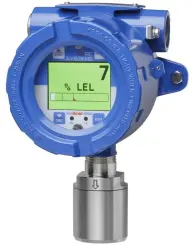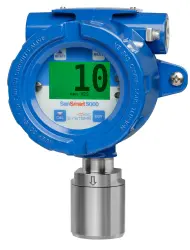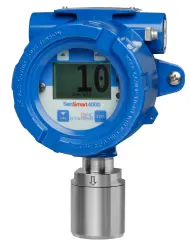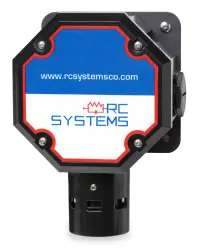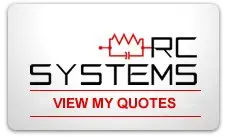Toxic Gas Detectors
Monitoring harmful gases in the ambient air can be challenging, but it’s crucial to ensure a safe industrial environment. Too much oxygen or toxic gas, such as hydrogen sulfide, chlorine, or ammonia, can present new dangers to employees and equipment in the area. Fortunately, the right gas detection and monitoring system can automate hazard detection, ensuring a safer environment and providing peace of mind.
Industrial toxic gas and oxygen gas detectors monitor the presence of gases in a specified area and sound an alarm when they reach dangerous levels. Gas detectors are typically installed where there is potential for a gas leak, and where unsafe gas levels pose an immediate danger to workers or critical equipment. Toxic gas detectors are widely used by industries including gas and oil, medical, mining, nuclear, construction, food and beverage , and industrial.
How Do Toxic Gas Detectors Work?
Toxic gas monitors and oxygen detectors function by measuring the concentration of specific gases in the air. RC Systems specializes in fixed gas detection solutions, offering both remote and locally mounted sensor options. Depending on the types of gases present and the size of the work area, multiple gas detectors may be installed to ensure comprehensive coverage and safety.
Gas detectors are programmed with pre-set levels that vary depending on the type and concentration of dangerous gas being monitored. A sensor inside the toxic gas detector reads the gas levels, and when they rise above or fall below the specified level, an alarm activates. Sensors are made from electrochemical cells, and the alarm can be visual or audible. Readings can be sent via a digital signal or analog signal to a control room, and alarms can actuate local relays for the operation of alarm safety devices such as horns, fans, valves, etc.
Using Oxygen Detectors to Monitor for Oxygen Levels
Normal oxygen (O2) levels in the atmosphere hover between 19-23%, but when they dip below that range, workers can experience drowsiness, nausea, and rapid heartbeat. In the workplace, depletion of oxygen can result from dilution caused by nitrogen, helium and other inert gases commonly used in laboratory, pharmaceutical or semiconductor applications.
Extremely low oxygen levels below 12% can cause loss of consciousness and, in extreme cases, death. Industrial oxygen sensors help prevent these dangers by accurately monitoring oxygen levels and triggering an alarm when they drop below 19.5%, which is the current OSHA-mandated level. Reliable O2 monitors help create safe rooms and working environments.
Preventing Workplace Dangers With Toxic Gas Detectors
Some toxic gases have a distinct smell, where others — such as carbon dioxide — have no smell and cannot be detected by humans. The presence of toxic gases at high levels presents serious health and safety risks, including explosion, fire, and illness or death. These potential dangers make toxic gas monitoring critically important.
Toxic gas detectors help prevent issues by monitoring potential leakage areas for harmful gas levels. Toxic gas detection systems are commonly used on oil rigs and in chemical plants and manufacturing facilities where toxic fluids and gases are being stored and processed.
The Different Types of Gases Industrial Detectors Can Monitor
RC Systems offers several different types of gas detectors, including toxic gas detectors and oxygen gas detectors. Each SenSmart oxygen or toxic gas detector model is designed to deliver optimum price, performance, and versatility to fit any situation.
Field swappable smart electrochemical sensors are available for Oxygen (O2) , Hydrogen Sulfide (H2S) , Sulfur Dioxide (SO2) , Ammonia (NH3) , Chlorine (Cl2) , Hydrogen Fluoride (HF) and many other toxic gases . SenSmart gas detectors offer important features including heated sensors (SenSmart 3100 & SenSmart 6100 ), Ethernet / Web Server (SenSmart 6100 ) and wireless communications with the easy-to-install SenSmart 7100. For lowest price points, consider the SenSmart 1100 and 2100 4-20mA loop-powered gas detectors.
To meet your unique gas detection requirements, each type of gas detector we offer can be custom configured based on the following criteria:
- Area classification
- Enclosure type
- Output option
- Gas type
- Sensor type
- Sensor range
- Sensor location
View the individual product listings below to learn more about our oxygen detector and toxic gas detector options, or contact one of our representatives to discuss your gas detection requirements. We also have an FAQ page that provides answers to common questions regarding our toxic gas detectors.
Our gas detection experts are available 24/7 to provide technical service and support—both during the selection process and after your toxic gas detector is installed.
What Is Hydrogen Sulfide Gas (H2S) and What Are Its Effects?
Hydrogen sulfide is a colorless toxic gas that can cause adverse effects on the human body at levels as low as 2ppm and can be fatal at levels as low as 100ppm with prolonged exposure. H2S is naturally occurring during the chemical breakdown of organic compounds in the absence of oxygen. Typical areas where H2S sensing, detection, and monitoring are a concern include oil refineries, wastewater facilities, oil and gas wells, tanks and compressor stations. Installing an H2S gas meter allows personnel to monitor H2S levels and maintain a safe working environment.
Selecting the Right Type of Gas Detector for Your Application
Important things to consider when selecting a toxic gas detector include:
- Reliability: This is perhaps the most crucial because oxygen detectors that frequently malfunction or have a short product life can put your workplace at danger.
- Features & Usability: You want to select an oxygen gas detector that is durable, easy to install, and can withstand the conditions of your operating environment. The device should also fit your data recording requirements and be easy to maintain and calibrate.
- Reading Sensitivity & Accuracy: Some gas detection applications require a higher level of sensitivity than others, so make sure your toxic gas detector can register readings within your required range.
- Alarm Response Time: When it comes to oxygen or toxic gas reaching dangerous levels, every second counts. Make sure the gas detector you select has a response time that allows you enough time to react and remedy the issue.
- Sensitivity to Environmental Factors: Depending on the operating environment, a gas detector might be exposed to heat, moisture, humidity, or other gases. It is critical that these factors do not affect the reliability of the readings and results provided by your toxic gas detector.
Learn More About the Various Types of Gas Detectors Offered by RC Systems
We offer a range of toxic gas detection systems and components and oxygen gas detectors and accessories to meet your safety requirements. Contact us today to learn more about our toxic gas detectors and other products, including alarm controllers, gas detection accessories, and more.



